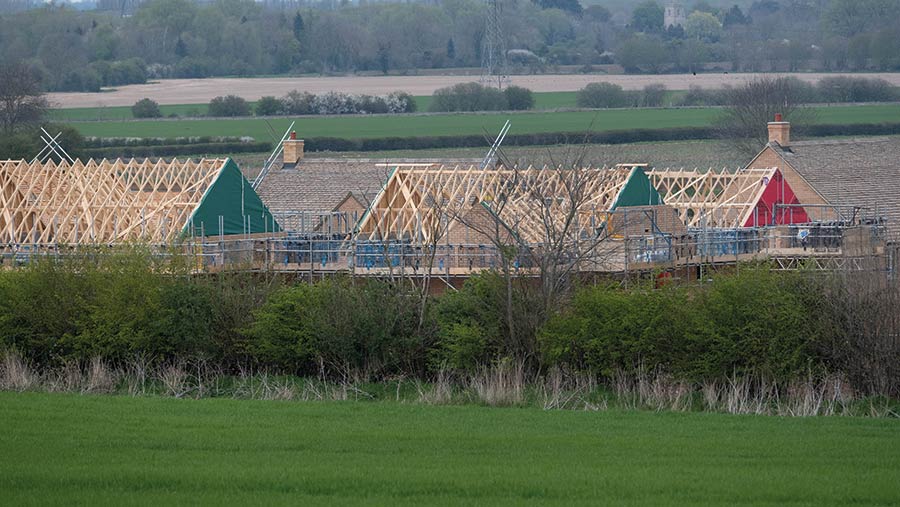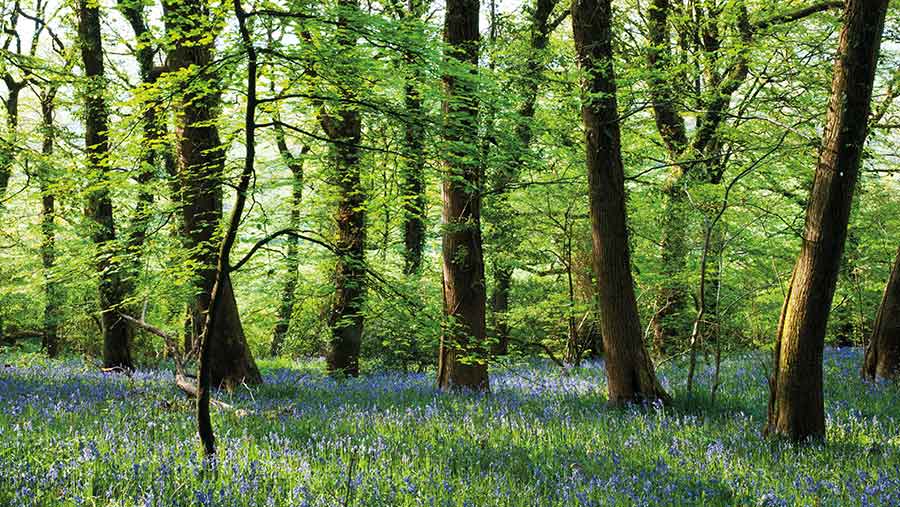Biodiversity net gain agreements: What farmers should know
 © Tim Scrivener
© Tim Scrivener Based on the premise that development damages biodiversity, it is expected that from November this year all planning permissions granted in England will have to demonstrate a minimum 10% uplift in biodiversity associated with their sites.
This biodiversity net gain (BNG) will be achieved by enhancing existing habitats or creating new ones, either on or off site, with some element of the latter likely in most cases.
Some local planning authorities have already adopted a BNG requirement for developments and are looking for more than a 10% uplift.
See also: Biodiversity net gain market – how will it work in practice?
Aside from the requirements of these early adopters, land is being sought by developers in anticipation of the statutory requirement to offset their obligations.
This can be through the purchase or leasing of land, and/or payments to landowners under long-term agreements to manage the land for BNG.
While this is one option through which some farmers may be able to gain income, it is a complex and developing market with a minimum 30-year commitment.
How is biodiversity measured and what is it worth?

© Lois GoBe/Adobe Stock
Biodiversity is assessed by a Defra measurement called Metric 3.1. This assesses an area’s value to wildlife, using habitat features to calculate a biodiversity value.
The metric calculates this in biodiversity units, using the size of the habitat, its quality and location.
Values will be dictated by supply, demand and the quality of habitats. Those with very high distinctiveness, such as ancient woodland or peatland, are far less likely to be able to achieve a significant net gain because those habitats are well established, say advisers, while grass and scrubland is more likely to be sought after.
Local authorities are suggesting values of £10,000 to £12,000 a unit, while Defra suggests up to £20,000 and the market offers evidence of higher sums in some cases, with some habitats achieving several units a hectare.
Peter Cole, associate partner with adviser Ceres Property, outlines three models under which landowners and farmers might offer habitat to allow developers to achieve their BNG obligations.
Direct model
Under the direct model, there is a huge amount of flexibility of contract, Mr Cole says.
This includes some straight sales or leases of land to developers for its BNG value potential, where developers will take complete risk and responsibility for creating and delivering the BNG habitat.
Landowners may see developers offering promotion and option agreements on their land which might help to de-risk, and covering some of the costs, which could be a good option, he says.
Self-delivery model
Here the landowner establishes their baseline, creates a biodiversity habitat that works within their farming business, then sells the biodiversity units generated from the creation of that habitat direct to developers.
The landowner then monitors and manages that land over the minimum 30-year term through a habitat management agreement, which sets out how the biodiversity gain is to be achieved.
Third-party delivery model
Under this model, the landowner leases land to a habitat bank provider or fund, which will sell the biodiversity units on to a developer.
The bank or fund rents the land for a minimum 30-year term and takes the risk, establishes the biodiversity habitat and looks to sell the biodiversity units generated direct to developers and take a profit.
They are likely to sub-contract the landowner back in and pay them to manage that land for biodiversity during the 30-year term
What is known about the BNG landscape
- Minimum 10% biodiversity uplift requirement for development sites from November 2023 – brought in under Environment Act 2021 and achieved through assessing habitats and valuing their biodiversity.
- BNG agreements will run for a minimum of 30 years and will be monitored.
- Delivering BNG will be monitored and enforced by the LPA or responsible body, using planning agreements such as Section 106 agreements or conservation covenants.
- There will be huge variation in supply, demand and values, in a very localised market.
- Under the BNG obligation, this must be new biodiversity (or at least created after January 2020), not something which is being done anyway and is well-established.
- Councils will also offer their own land for BNG and there will be statutory biodiversity credits, traded by the Secretary of State – these are likely to be the last resort for developers and will be high priced.
- A BNG national register will be established, which will be publicly accessible.
- Secondary legislation is needed on many aspects.
- LPAs in England are rolling out their Local Nature Recovery Strategies, which are expected to lead to higher values for BNG units in the areas they cover
- Biodiversity units can be assessed and used in the farmer’s own business (known as “inset” rather than “offset”).
- BNG will also be required for Nationally Significant Infrastructure Projects from the end of 2025.
What are the unknowns
Terms of the secondary legislation needed for BNG clarity are still to be announced.
These regulations should cover the biodiversity net gain plan, exemptions, irreplaceable habitats, phased developments, the net gain register, statutory biodiversity credits, and whether there are any incentives and procedures for tenants.
Questions remain over the test for additionality (to ensure that the BNG is additional to what would have been done in any case) and the ability to which different ecosystem services such as BNG, carbon credits, water management and renewable energy may be stacked on the same land and sold separately, or bundled and sold as a package.
Who will hold the BNG register and what form it will take are also unknown. Some suggest it could be a “Rightmove” for BNG, searchable for sites offered, or that it will be a register of confirmed BNG agreements.
The income and capital tax treatments of payments and reliefs are yet to be confirmed. There is also a question over VAT, in terms of whether landowners will be providing a supply or a service.
The end of BNG agreements also raises questions. “We don’t know what’s going to happen in 30 years’ time,” says Ceres Property associate partner Kathryn Brown.
“The expectation is that the land use change has to be permanent.
“We don’t know if that means it will be designated in some way or whether it is just going to be covered under the existing designations, like the regulations that protect hedgerows and permanent pasture.
“We don’t think it is going to be likely that you’ll be able to return the use to whatever it was that you had before, if it degrades the habitats. It doesn’t mean that the land is going to be useless.
“Land managers could look to try to enhance the land further or create other natural capital to be able to sell other ecosystem services later on, or continue farming it, or use them as insets.”
What should landowners do now?
Landowners should look out for more information on the net gain register, what it might cost to register, the process and protocol, advises Mr Cole.
Housing supply in a landowner’s area should also be considered – if LPAs are behind on housing delivery, more BNG sites will be needed.
Landowners can also assess their baseline for biodiversity so they are in a position to enter the net gain register when the process is announced, or enter into arrangements with third parties.

© Carolblaker/Adobe Stock
The length of the agreements makes it likely that BNG will be a cross-generational issue for some families, which should be considered before signing up, advises Ms Brown.
Planning adviser John McLarty says LPAs are employing more enforcement officers to monitor development activity and there are questions over how BNG will be managed over the longer term.
There is a distinct change in the planning system, says Mr McLarty, with individual local authorities being given more scope to make decisions about housing numbers, and the government’s previous target of 300,000 new homes a year now being a notional figure. Local elections in May are likely to colour decisions, as is the national election in 2024 or 2025.
Legal considerations
It is expected that LPAs will want a commitment, possibly through a Section 106 agreement or a conservation covenant, to ensure the landowner of a BNG site delivers the BNG requirements, says Sophia Key, partner and head of natural capital at law firm Birketts.
A conservation covenant would be directly with the LPA or a responsible body (such as a conservation organisation) and registered as a local land charge, which would bind successors in title to the terms of the covenant for the minimum 30-year period.
Where habitat banks or funds are involved, they will take a lease of the land, sometimes offering a leaseback to the owner to put them back in occupation for tax and management control purposes.
They will often ask the landowner to continue monitoring and managing the habitat by entering into a habitat management agreement similar to that in the self-delivery model, paying a rent under the lease and a habitat management fee.
This model will also involve a Section 106 or conservation covenant commitment with the LPA or responsible body, says Ms Key.
In this context, landowners should be aware that if the developer or land banker stops paying the landowner, the landowner remains under an obligation to the LPA or responsible body to deliver the habitat.
This means looking at getting as much money up front as possible under BNG arrangements, to mitigate that risk, says Ms Key, and there may be a place for bonds or some other form of protection in the natural capital sphere too, but this is yet to develop.
If the landowner breaches the terms of the habitat agreement or the conservation covenant, either wilfully or accidentally, they will most likely face procedures through breach of contract for damages or specific performance in terms of putting the habitat back as it should have been.
There is also discussion of the possibility of insuring against a landowner’s own breach, or against non-payment by the developer.
Generally, the habitat bank providers under the third party delivery model are reserving all natural capital opportunities to themselves, including carbon capture, nutrient neutrality and public funding such as BPS, Countryside Stewardship and ELM, says Ms Key, although they may give an overage for the land owner to share in that.
BNG is also likely to have land value implications, while tax is a huge consideration, the most important aspect of which is relief from inheritance tax, meaning advice is needed at an early stage so deals can be structured in the best possible way.
